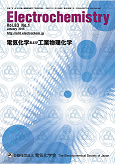Volume 83, Issue 11
Displaying 1-20 of 20 articles from this issue
- |<
- <
- 1
- >
- >|
Preface
-
2015 Volume 83 Issue 11 Pages 949
Published: November 05, 2015
Released on J-STAGE: November 05, 2015
Download PDF (419K)
Articles
-
2015 Volume 83 Issue 11 Pages 950-955
Published: November 05, 2015
Released on J-STAGE: November 05, 2015
Download PDF (1010K) -
2015 Volume 83 Issue 11 Pages 956-961
Published: November 05, 2015
Released on J-STAGE: November 05, 2015
Download PDF (3094K) -
2015 Volume 83 Issue 11 Pages 962-968
Published: November 05, 2015
Released on J-STAGE: November 05, 2015
Download PDF (3022K) -
2015 Volume 83 Issue 11 Pages 969-973
Published: November 05, 2015
Released on J-STAGE: November 05, 2015
Download PDF (2701K) -
2015 Volume 83 Issue 11 Pages 974-978
Published: November 05, 2015
Released on J-STAGE: November 05, 2015
Download PDF (4014K) -
2015 Volume 83 Issue 11 Pages 979-983
Published: November 05, 2015
Released on J-STAGE: November 05, 2015
Download PDF (1747K) -
2015 Volume 83 Issue 11 Pages 984-988
Published: November 05, 2015
Released on J-STAGE: November 05, 2015
Download PDF (2407K) -
2015 Volume 83 Issue 11 Pages 989-992
Published: November 05, 2015
Released on J-STAGE: November 05, 2015
Download PDF (669K) -
2015 Volume 83 Issue 11 Pages 993-996
Published: November 05, 2015
Released on J-STAGE: November 05, 2015
Download PDF (4524K)
Technological Report
-
2015 Volume 83 Issue 11 Pages 997-999
Published: November 05, 2015
Released on J-STAGE: November 05, 2015
Download PDF (828K)
Topic
-
2015 Volume 83 Issue 11 Pages 1000
Published: November 05, 2015
Released on J-STAGE: November 05, 2015
Download PDF (172K) -
2015 Volume 83 Issue 11 Pages 1001-1005
Published: November 05, 2015
Released on J-STAGE: November 05, 2015
Download PDF (2519K) -
2015 Volume 83 Issue 11 Pages 1006-1011
Published: November 05, 2015
Released on J-STAGE: November 05, 2015
Download PDF (6355K) -
2015 Volume 83 Issue 11 Pages 1012-1015
Published: November 05, 2015
Released on J-STAGE: November 05, 2015
Download PDF (2113K) -
2015 Volume 83 Issue 11 Pages 1016-1020
Published: November 05, 2015
Released on J-STAGE: November 05, 2015
Download PDF (4094K)
-
2015 Volume 83 Issue 11 Pages 1021-1031
Published: November 05, 2015
Released on J-STAGE: November 05, 2015
Download PDF (2779K)
Salon
-
2015 Volume 83 Issue 11 Pages 1032-1040
Published: November 05, 2015
Released on J-STAGE: November 05, 2015
Download PDF (1594K)
-
2015 Volume 83 Issue 11 Pages 1041-1045
Published: November 05, 2015
Released on J-STAGE: November 05, 2015
Download PDF (1104K) -
2015 Volume 83 Issue 11 Pages 1046
Published: November 05, 2015
Released on J-STAGE: December 27, 2023
Download PDF (511K)
- |<
- <
- 1
- >
- >|
